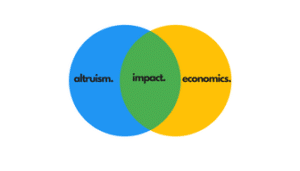- The Meaning of Critical Thinking: A Key Skill for Navigating Today’s Information Landscape - November 3, 2025
- Grandparents Can Develop Activist Grandchildren - September 29, 2025
- Top Six Reasons Credit Union Benefits Are a Smart Choice Over Banks - August 18, 2025
Last Updated on September 21, 2025

You’ve seen the commercials. Eyes glistening, the puppy gazes at the camera with a “Don’t let me die here” expression. If you don’t send in $1.50 a month, that’s less than the cost of one coffee, by the way, little Fido is doomed. The ad tugs at your heart and your purse strings.
How are we supposed to quit opening our wallet for every dewy-eyed commercial spokesperson or animal?
All it takes is two steps.
Step 1: Be clear about your values and choose an issue important to you.
Choose an issue that reflects your values. Then, every time you see a commercial, or people knock on the door, or your employer asks for automatic deductions from your paycheck for the United Way, say no. If you feel like being frank, tell them about your cause. If you are feeling cheeky, ask them for money.
Step 2: Once you know your issue, find a charity that makes the best use of your donation.
In his article The Maximum Good: One Man’s Quest to Master the Art of Donating reporter AJ Jacobs set out to get the biggest bang for his 1000 charitable bucks. Along the way, he learned about effective altruism, a movement that evaluates charities to ensure donations dramatically improve a vast number of lives, make a significant change, and contribute to overlooked causes.
Will it dramatically improve a vast number of lives?
It makes sense to want your donations to impact many lives. But some charities might have less impact than others. For example, Jacobs provides a sobering evaluation of animal activism.
Remember Fido? Animal suffering is undoubtedly worthy of being alleviated because in the U.S., shelters kill three million dogs and cats every year. But compare this to the approximately nine billion chickens and tens of millions of pigs and cows killed in factory farms. Jacobs concludes that we impact many more lives by supporting charities that save factory-farmed animals.
Will it make a significant change?
Effective altruists also evaluate the charity’s ability to make change. Within a particular cause, some charities make more difference than others. For example, providing anti-malarial bed nets offers 500 times the benefit of treating the disease.
Is the cause neglected?
Effective altruists consider how much a cause is neglected. People in wealthy nations tend to donate locally, so charities in poorer countries are underfunded. Our money may go much further if we send it overseas.
The Effective Altruism and Givewell websites help you choose charities that dramatically improve a vast number of lives, make a significant change, and focus on overlooked causes. They vet the charity and calculate the impact for you.
Summary
What is effective altruism? To recap, two steps.
- Step 1: Identify the charitable cause most important to you.
- Step 2: Find the charities that are most effective for your cause and send them money.
Now relax, knowing that you maximized the donation impact for an issue you care about. And if you switch on the TV and see a dewy-eyed child beseeching you with a “Don’t let me die here” expression, don’t send in 1.50 a month, even though it’s less than the cost of one coffee.
You are good.
READ NEXT
See how to apply these same principles to your activism.
How to Get the Best Results From Your Donations
How to Find the Best Activism Method
At the Intersection of Crafting and Activism



